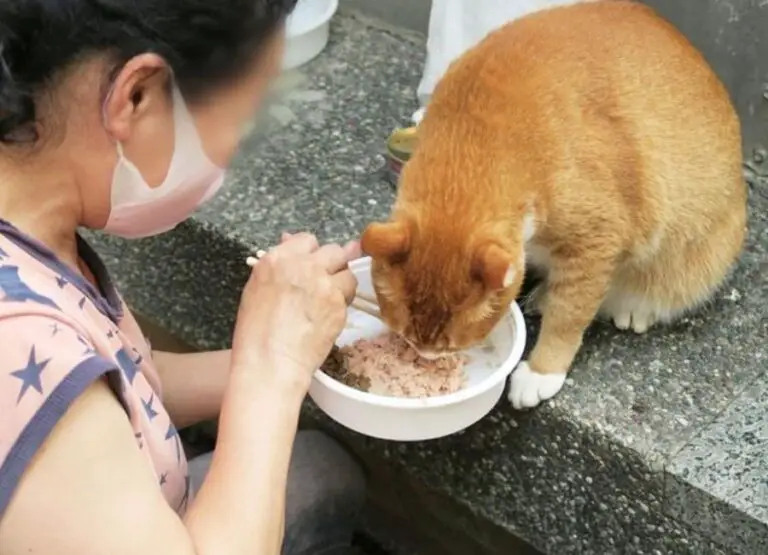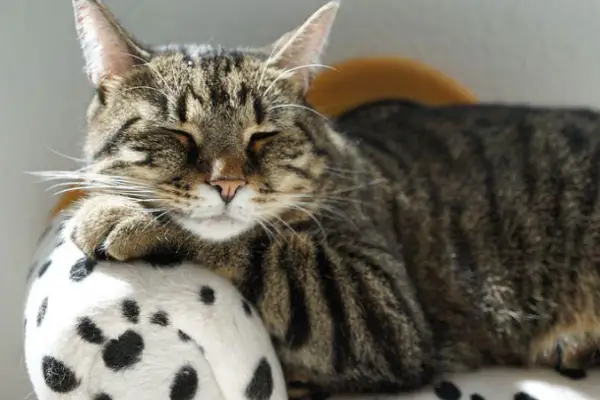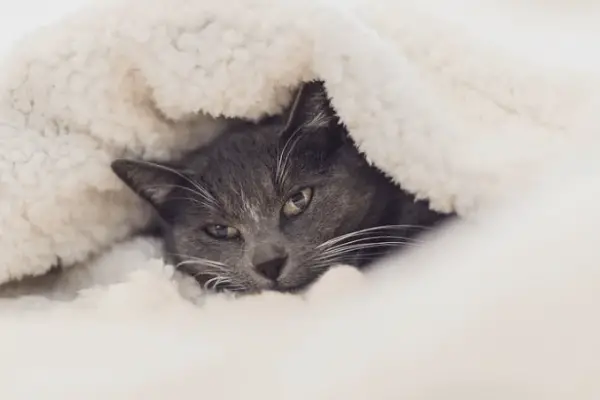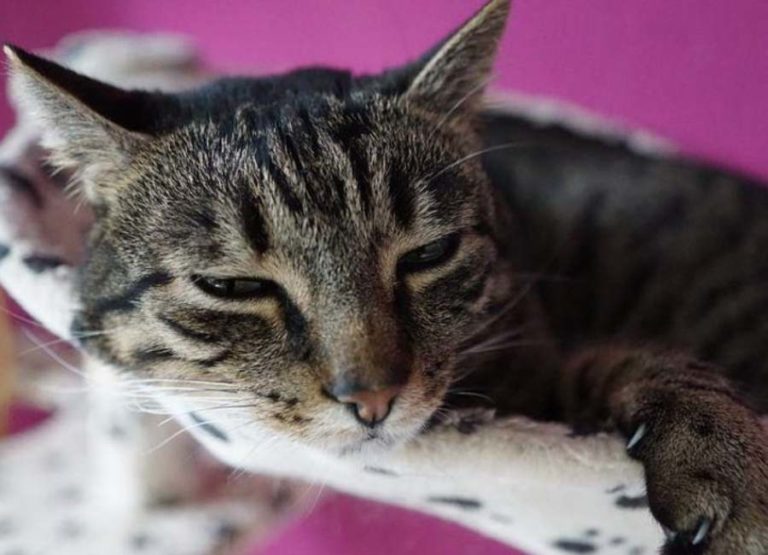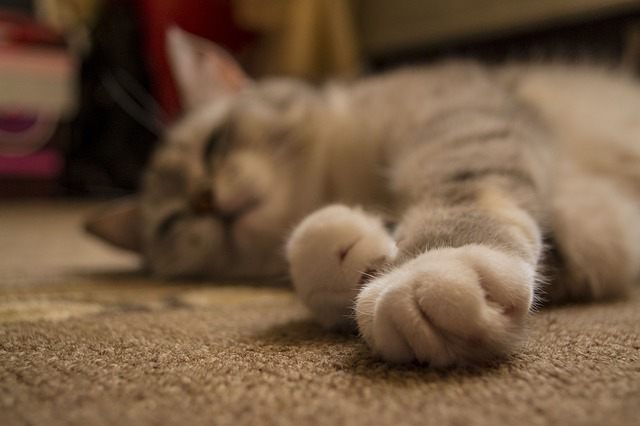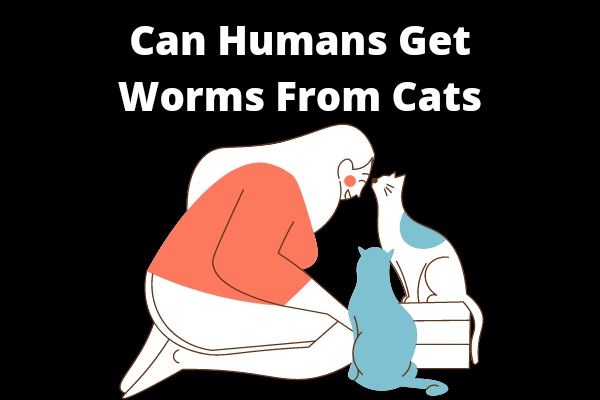13 Common Dying Cat Symptoms & Ways To Comfort Them
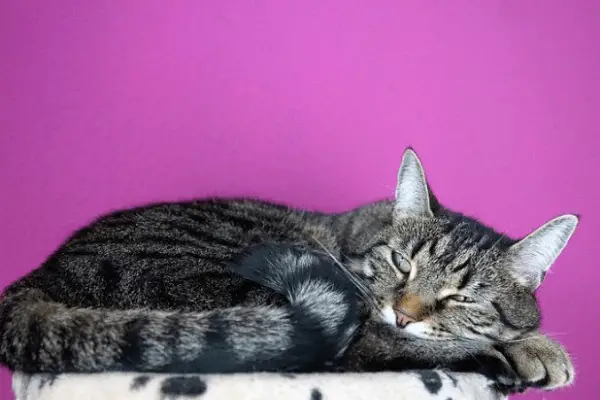
Cat owners always seek to know the visible and common dying cat symptoms, and that is exactly what this post is all about, so keep reading.
With my years of experience living with cats, I will simply discuss the most common dying cat symptoms you should know.
The dying cat symptoms you see in this post can be seen in groups of 3 or more, this means once you see one of the dying cat symptoms, you should also look to see others before saying your cat is dying.
So, let’s discuss…
Common dying cat symptoms
Here are some of the most common signs of a dying cat you should know:
1. Persisting lethargy
Your dying cat will become increasingly sluggish, sedentary, and unwilling to move. Their frailty in their rear legs will be obvious, and they will also sleep a lot more than normal.
Extreme and persisting lethargy in cats is the most common sign that the dying process has begun.
Your cat may not have the stamina to jump up and respond when his name is called while he is dying.
Not acting like themselves, lying in one position, often in a quiet location where they don’t typically lie, disinterested in toys, seldom recognizing family members, and so on.
If your cat keeps having a persistent lethargy even after your visit to the vet, then the end may be near.
Read more: How To Comfort A Sick Cat (14 Useful Tips).
2. Decreased rate of mobility
As the dying cat approaches death, his or her strength may diminish to the point where he or she is unable to stand for as long as previously.
The legs of your dying cat may get tired, making it harder for them to climb stairs or cross slippery surfaces.
If your cat has arthritis, your veterinarian can prescribe pain drugs that are safe for cats to help them feel better.
Due to muscle loss and suffering from arthritis or other health issues, senior cats frequently have limited movement.
In the absence of arthritis, your cat is heading towards its end.
Weakness commonly progresses, beginning with the inability to leap up onto the kitchen counter and progressing to difficulties traversing stairs and even being unable to enter and exit a tall litter box.
3. Fluctuations in appetite
If you’re positive your cat doesn’t have worms or dental problems and sheds excessively on a resting location, it’s time to say goodbye.
When a cat is dying, its cent cells get weaker, which might lead to your dying cat disregarding food on a regular basis as its internal organs deteriorate.
A change in your cat’s appetite can be caused by a variety of conditions, so this isn’t always an indicator that he’s dying.
Cats, on the other hand, typically stop eating or modify their food behaviors as their final day approaches.
Changes in your cat’s food habits that aren’t expected are worrying and might suggest that the end is near.
4. Persistent fluctuations in body temperature
Senior cats are more vulnerable to heat and cold than healthy adult cats because they have problems regulating their body temperature.
Cats nearing death frequently have a low body temperature, even when supplied with a warm bed and environment.
It’s possible that the limbs of your cat are chilly to the touch.
A dying cat’s ability to control their own body temperatures may deteriorate, leading them to lose body heat often.
As a result, a dying cat’s body temperature will be lower than usual, which the owner would notice.
Just remember that if you live in a cooler climate, your cat may grow overheated, and if you don’t, your cat may die or become unwell.
5. Drastic changes in weight
As cats age, they tend to consume less as they grow weaker, which can result in weight loss, which is common in senior cats.
Most cat owners will find it tough to see their dying cats suffer, and going through it with your cat will require courage.
If your sick cat continues to lose weight after your vet has ruled out all other possibilities, it’s time to say goodbye.
Senior dogs seldom become hungry and skinny simply because of their age.
Degenerative illnesses such as chronic renal or hepatic insufficiencies, as well as cancer, can all lead to your cat’s mortality.
6. Increased self-isolation
Hiding is a clear indicator of disease in cats, but it can be difficult to quantify because many cats naturally conceal a lot.
Increased hiding, hiding in unfamiliar areas, and refusing to come out even for typical positive occasions like mealtimes are all signs to keep an eye on.
A dying cat intuitively recognizes that it is more susceptible to predators in the wild.
The hiding is a means for them to stay safe. When the end is near, domestic cats adopt a similar instinctual habit.
A dying cat will prefer to be alone as they feel stressed with the presence of other animals or humans.
7. Abnormal appearance and odor
Your cat may acquire an odd body odor as she approaches the end of her life.
Your cat may acquire an odd body odor as she approaches the end of her life.
This occurs as a result of the breakdown of tissues and the accumulation of toxins in the body.
Depending on the underlying disease, the particular fragrance might differ in different cats.
Cats with diabetic ketoacidosis have a sickly sweet odor, and cats with renal failure may have ammonia-smelling breath.
When cats are dying, they often stop grooming themselves, and this results in an oily, unkempt coat.
Mats can form on the hindquarters, underside, and behind the ears in long-haired cats when they stop grooming due to the fact they are dying.
Because of the lowered pace of grooming, your dying cat may have extensive dandruff and dry skin.
8. Changes in the rate of breathing
Changes in the rate of breathing are one of the most common dying cat symptoms you should look out for.
Muscles and nerves govern your cat’s lungs, and these are not impervious to collapse as your cat matures.
A dying cat’s breathing pattern may be irregular, with her respiratory rate speeding up and slowing down at random intervals.
She may even stop breathing for a brief length of time before restarting.
Open-mouth breathing, straining her head and neck straight out from her body, and forceful abdomen motions as she breaths are all signs of trouble breathing.
If your cat exhibits any of these signs, she is having trouble getting oxygen into her body.
This is a critical situation and shows the end is near.
9. Uncontrollable potty accidents
Repeated house accidents are also one of the most common dying cat symptoms to look out for.
Incontinence, or the inability to control urination, is a typical problem in geriatric cats or those that are dying.
The muscles begin to relax as the body prepares to shut down, to the point that the cat loses control of its eliminations.
The bladder and sphincter muscles relax, causing the cat to make involuntary motions. This will most likely happen soon after the cat has died.
Taking your cat to the vet after a domestic accident might be beneficial at first, but as time passes, the vet may become less involved in the last days.
10. Complete loss of interest in favorite activities
A continuous loss of interest in favorite activities could be a sign that your cat is sick or one of the dying cat symptoms.
Your cat’s interest in things she used to like will wane as her health deteriorates.
She may stop playing with her toys, refuse her favorite foods, and even stop purring when handled.
Your cat’s lack of interest in the world around her and excitement for things she used to like are signals that she’s ready to go.
11. Resisting treatments or medications
If your cat’s body or system keeps showing resistance to many forms of treatment from the vet then it might be dying cat symptoms.
Many of the disorders that affect older cats can be managed for a long time with drugs and other therapies.
Your cat may require greater medication doses or cease responding to therapy over time.
This might indicate that her body is breaking down, and she is no longer able to take her meds as prescribed.
12. Repeated loss of coordination
The next major sign that a cat is dying is the full loss of balance and motor function, and there is little you can do about it.
If your cat stands up and moves about, he or she may seem wobbly or disoriented, indicating that coordination is failing.
They may quiver or convulse when laying down, which is never a good indication for your cat.
As much as possible, confine them to a small, peaceful, and comfortable place, and remove anything they could bump into or knock over.
Safeguarding your cat, establishing a secure atmosphere for them, and providing them with any aid they require are all part of saying farewell to your cat.
13. Changes in cat personalities
Cats are creatures of habit, so they tend to stick to the same mealtimes, napping areas, and toy routines.
If you observe any significant changes in your cat’s behavior, it might be an indication that they aren’t feeling well.
Your normally gregarious cat may have turned to nap beneath the bed, or they may have stopped playing altogether.
Knowing your cat’s typical behavior is a good starting step toward noticing when something isn’t right.
Your cat may be missing for long periods of time, skip meals, or have irregular sleeping patterns.
When cats are dying, they can exhibit a wide range of behavioral changes. The specific modifications will differ from cat to cat, but what counts is that she has adjusted her behavior.
Some cats will become more reclusive, angry, and grumpy. This might be related to discomfort or cognitive problems.
Other cats become friendly and attached, wanting to be near to you at all times.
Ways to comfort a dying cat
The most frequent approaches for soothing a dying cat are as follows:
- Use a quiet and soothing tone to talk to your dying cat.
- Give your dying cat all the medical attention and drugs he or she requires.
- Provide a relaxing and peaceful atmosphere for your dying cat.
- Provide a higher-quality food for your cat and keep a water dish accessible.
- Spend more time with your dying cat.
- Reduce the number of new activities or workouts your dying cat does.
- If he becomes chilly, make sure there are lots of blankets or cover him up.
- In your dying cat’s resting quarters, avoid loud noises and strong lighting.
- Keep your dying cat’s temperature in check
- To avoid surprising him, carefully approach him and gently touch him.
- Smaller meals should be given to your cat at regular intervals.
- It’s critical to respect your cat’s need for privacy.
- To guarantee that your dying cat eats, you can use appetite enhancers.
- Avoid movements around your dying cat.
- Always keep an eye on your dying cat to see whether he or she needs help.
- Never shout at your dying cat.
I hope the information provided on this page resolves your concerns about dying cat symptoms!

